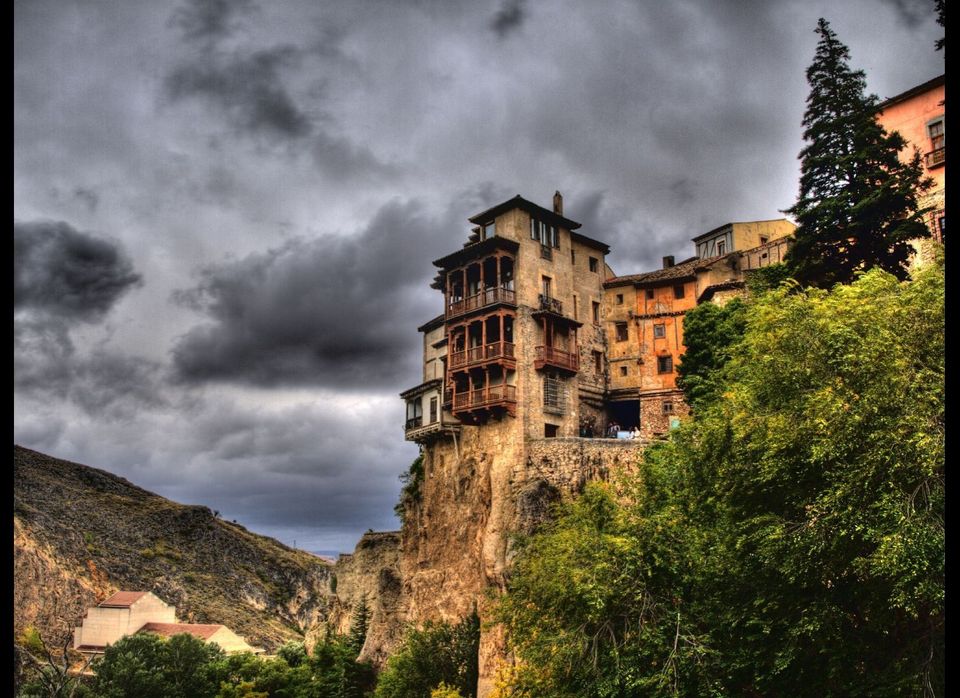Rain and wind envelop the Huecar River gorge, sending hats swirling and turning umbrellas inside out as travelers make their way across an iron bridge toward the center of Cuenca, a medieval Spanish town that charms with its hanging houses, stone steps and ancient artifacts.
In some cities, the severe weather might be enough to stall tourists, but in Cuenca, with its legacy of Muslim, Christian and Jewish roots, the weather almost seems to add to the drama of this place where the Moors ruled in the 8th Century.
In some ways, time appears to be standing still, carved in stone and perched on a precipice 3,300 feet above the Huecar River. That's because Cuenca's most iconic image, the Casas Colgadas, or Hanging Houses, dominate the landscape. The houses date at least to the 14th Century, some say to even earlier. Today, the structures house an art museum and a restaurant and create a mesmerizing skyline that seems to burst from stone.
"Sometimes you can't see where the house ends and the rocks start," said tour guide Luis Noe. "In Cuenca, we had skyscrapers before New York."
In addition to the hanging houses, other buildings in Cuenca are constructed on many levels with entrances at street level and interior floors further down the cliff sides.
Cuenca is about 100 miles from Madrid in central Spain in the province of Castille-La Mancha, yes, that La Mancha, the one of Don Quixote fame. In fact, you could do a complete tour of sites mentioned in the Miguel de Cervantes book by following any of many Don Quixote routes outlined by the Spanish government, covering more than 600 miles in the La Mancha region.
The ancient is always present in Cuenca, but, surprisingly, modern art is a key attraction for tourists in this city of 50,000. At least three museums focus on modern art, and in the city's remarkable Cathedral Santa Maria de Gracia, which was consecrated in 1208 and houses a Virgin Mary statue dating to the 12th Century, stained glass windows designed by Gustavo Torner were installed in 1993.
The yellow, orange and white windows are a brilliant, abstract representation of DNA, the molecules of life, and seem perfectly at home in the historical setting. The Museo de Arte Abstracto Espanol, housed in the Casas Colgadas, was opened in 1966 when artist Fernando Zobel brought his collection to Cuenca. Works from the likes of Torner, Saura, Rueda, Chillida and Tapies can be found here.
Just outside the cathedral is the old town's central area with bars and restaurants, many with outdoor seating, grouped in among the brightly colored buildings. It's a perfect place to sit and watch the world go by.
Places to stay:
The Convento de San Pablo, built in the 16th century, is now the Parador of Cuenca, a 4-star hotel, part of a collection of some 90 inns, most with historical significance, run by the Spanish government. Low-season rates begin at 130 Euros per night, including an elaborate breakfast buffet. This parador, which housed monks until 1975, is a delight, with rooms overlooking the spectacular river gorge and hanging houses, comfortable seating areas and even a bar with an elaborately painted ceiling. The parador serves local wines and cuisine including the morteruelo, a traditional dish using game meat that seemed like a warm pate. Definitely worth a try. Even if you don't stay overnight at this parador, you should stop for a meal in its fine restaurant where Chef Gines Navarro shines.
Less expensive is the Posada de San Jose, built in the 18th century. It's a quirky little place with 22 rooms in the heart of the old town. It offers rooms at less than 90 Euros per night, depending on season. Ask for one with a view. We liked the room with the small balcony.
Festivals:
The town's biggest festivals are in the spring and fall.
Holy Week is a big deal here, as you might expect. The Holy Week festival features processions through the town, the most famous of which is held at daybreak on Good Friday. Religious sculptures, most from the mid-20th Century but at least one dating to the 16th Century, are carried through the town in the processions. Celebrated simultaneously is the Religious Music Week Festival, which each year draws renowned composers and performers of sacred music.
In the fall, the big event is the festival of San Mateo, which celebrates the conquest of Cuenca in 1177 by Alfonso the 8th. Expect parades, concerts, fireworks and a running of the bulls through the cobblestone and stone-walled streets. The holiday is celebrated on Sept. 21, a great time to visit this part of Spain.
For general information on visiting Spain, check out www.tourspain.es
